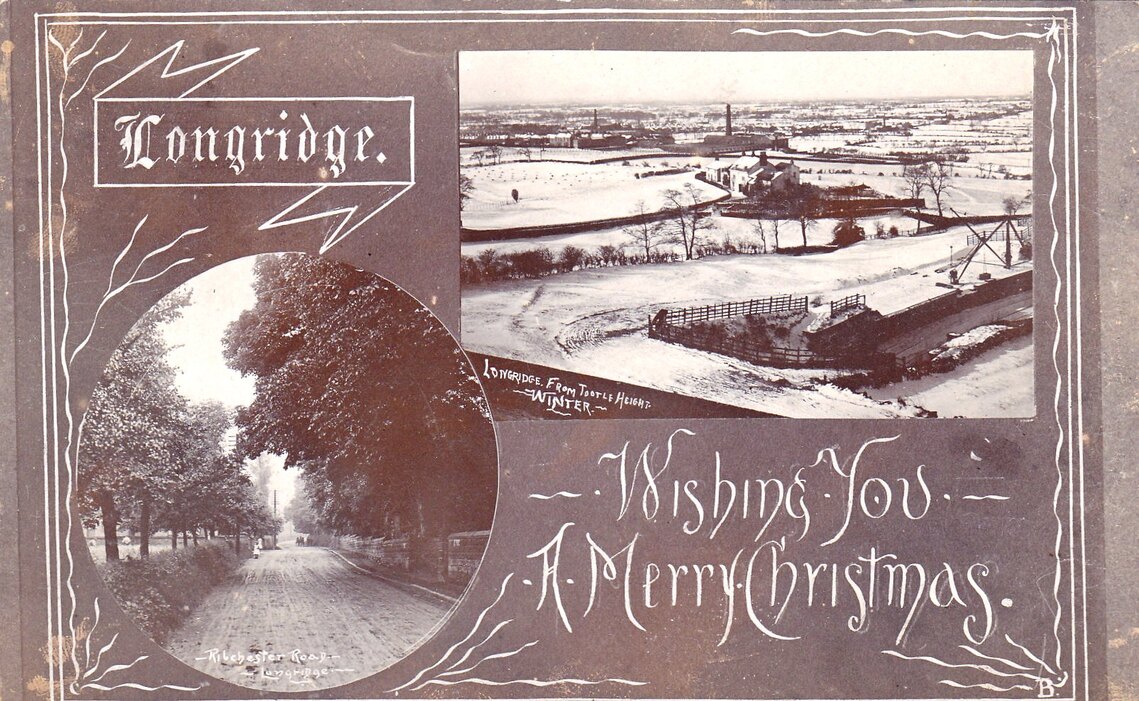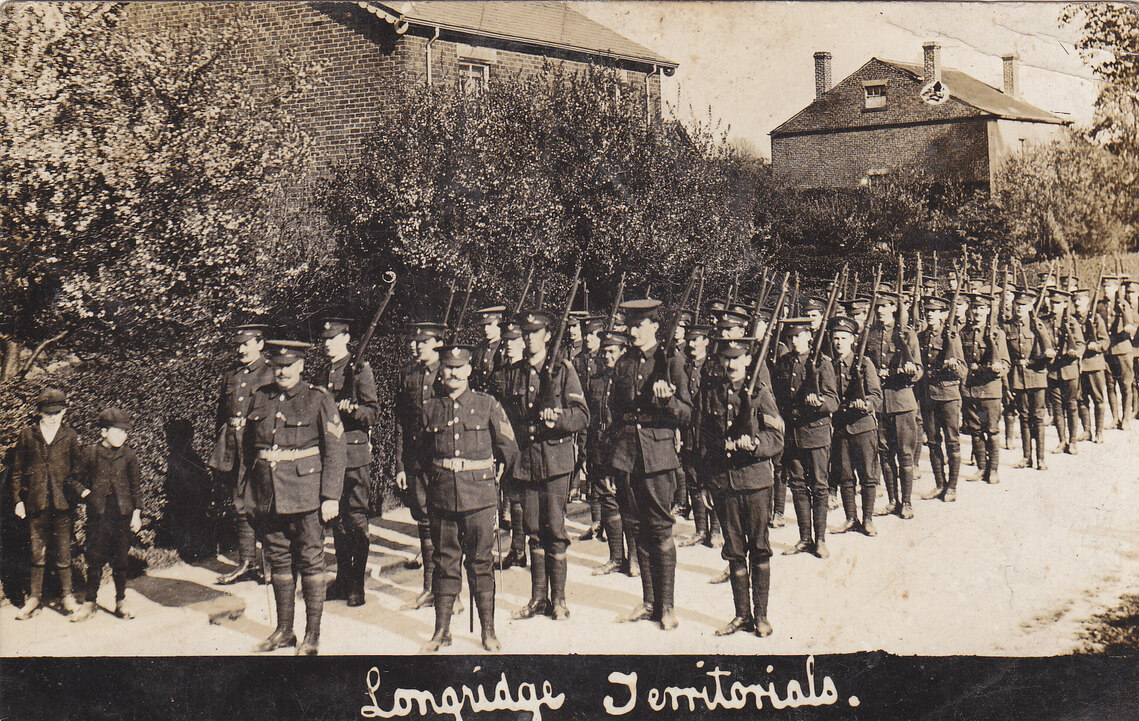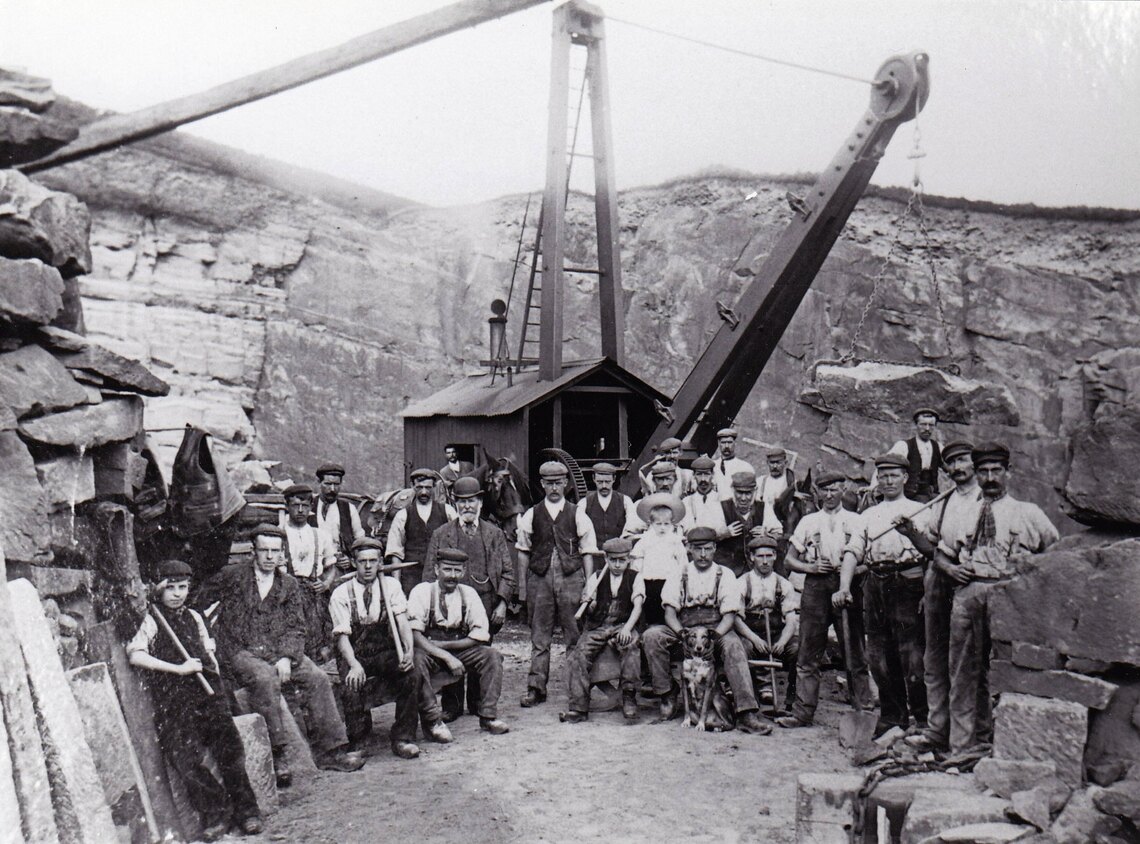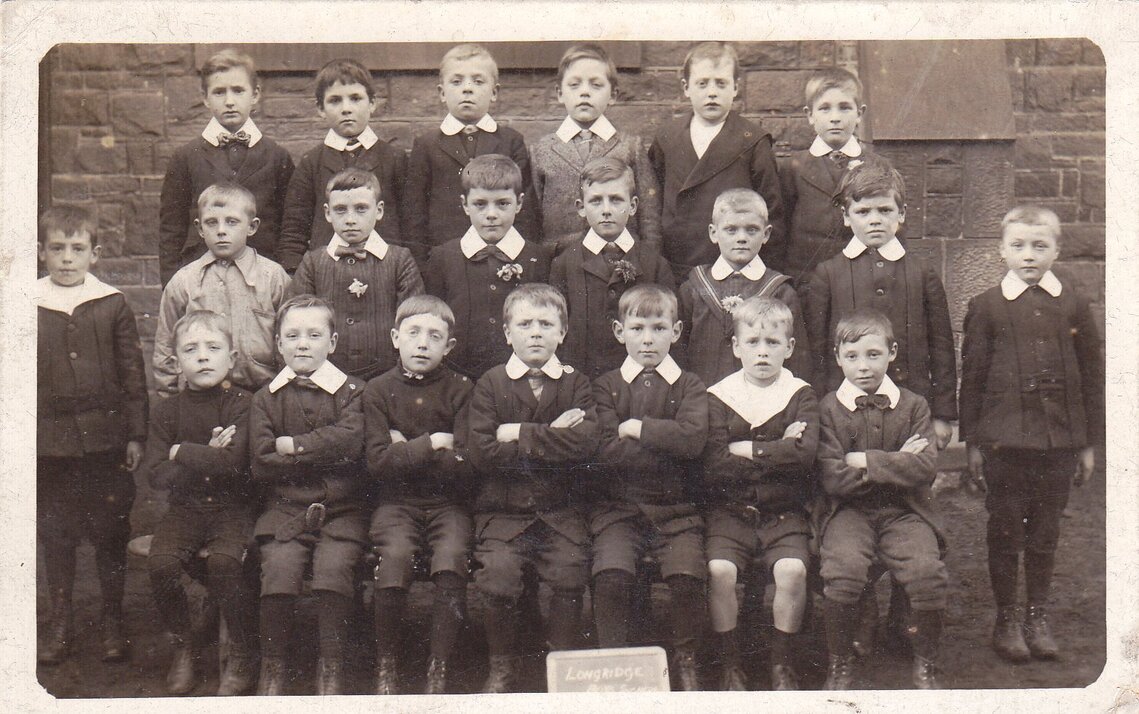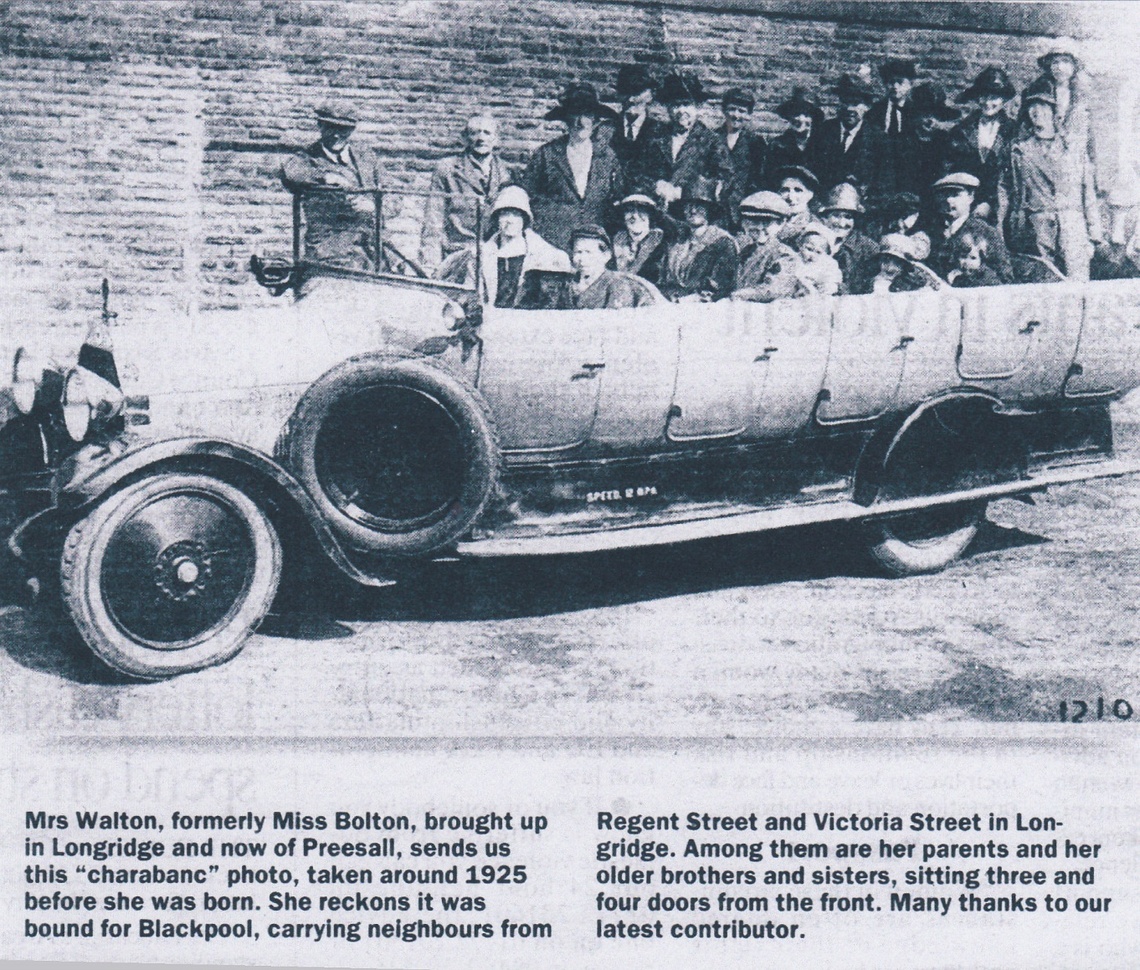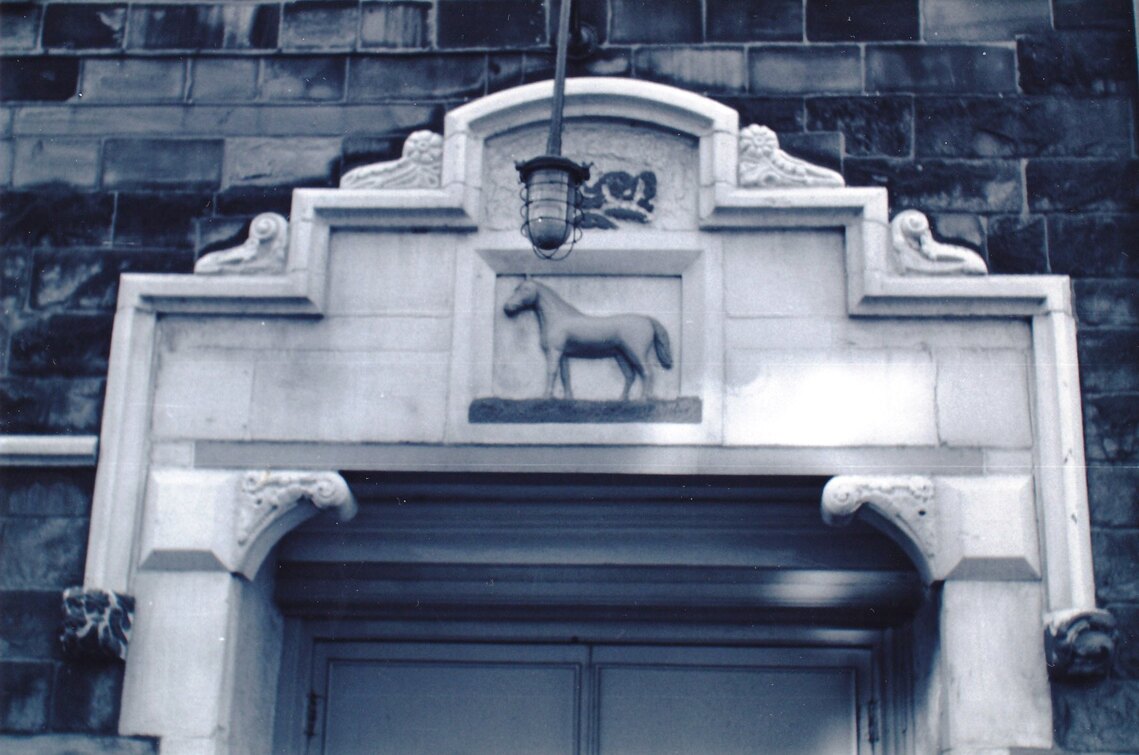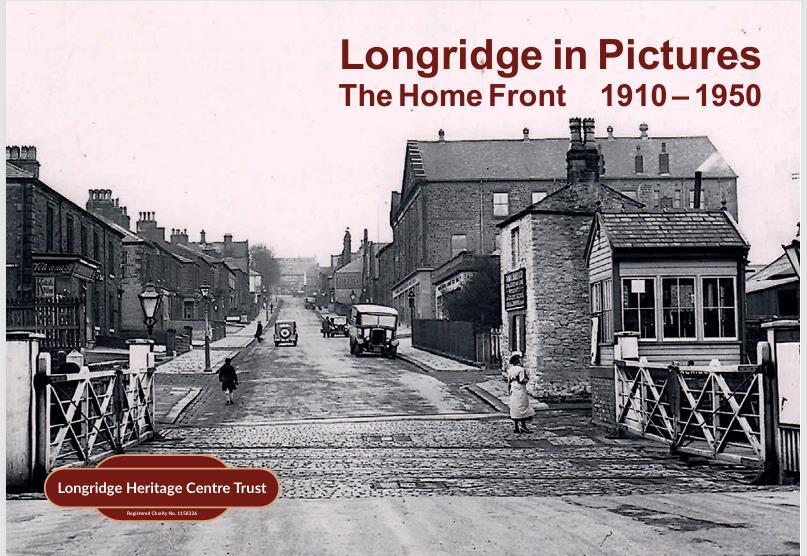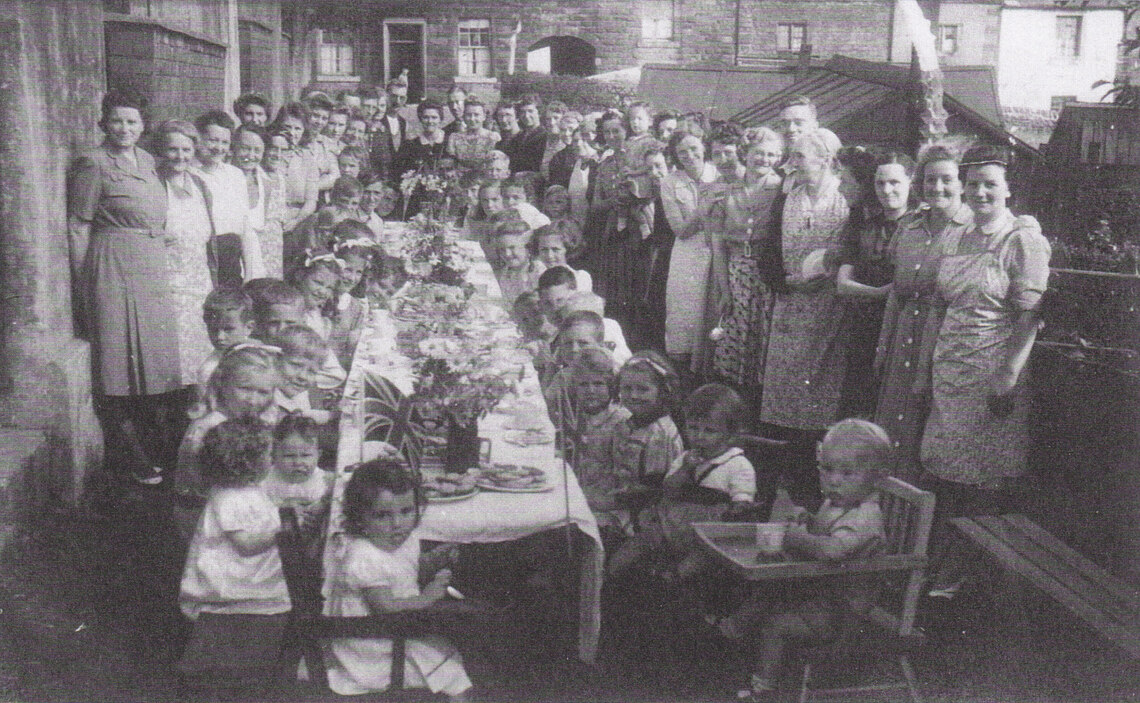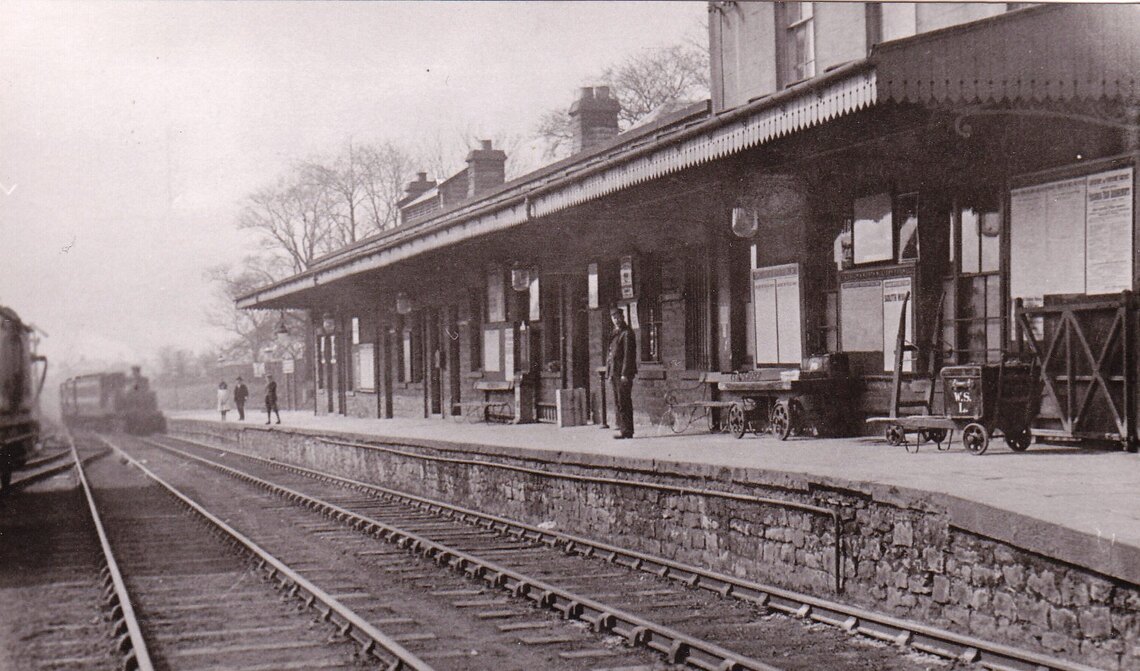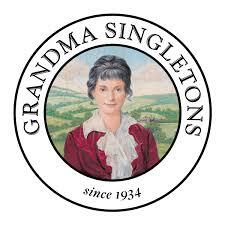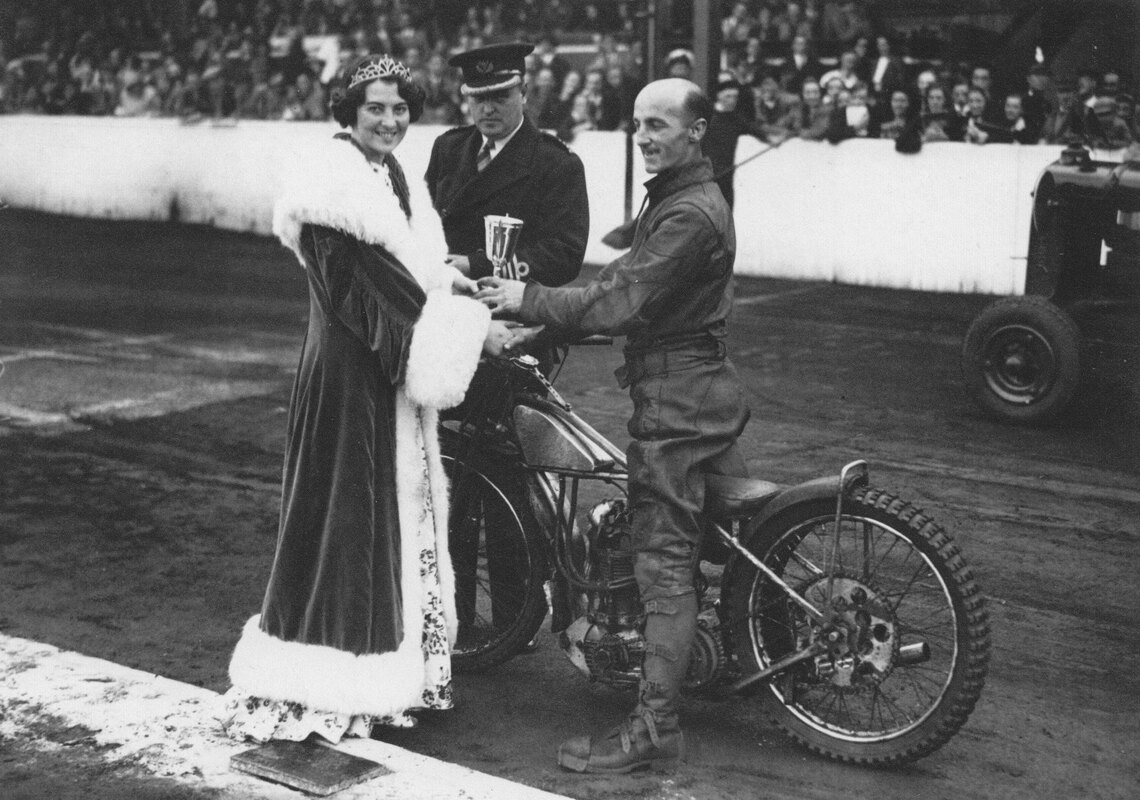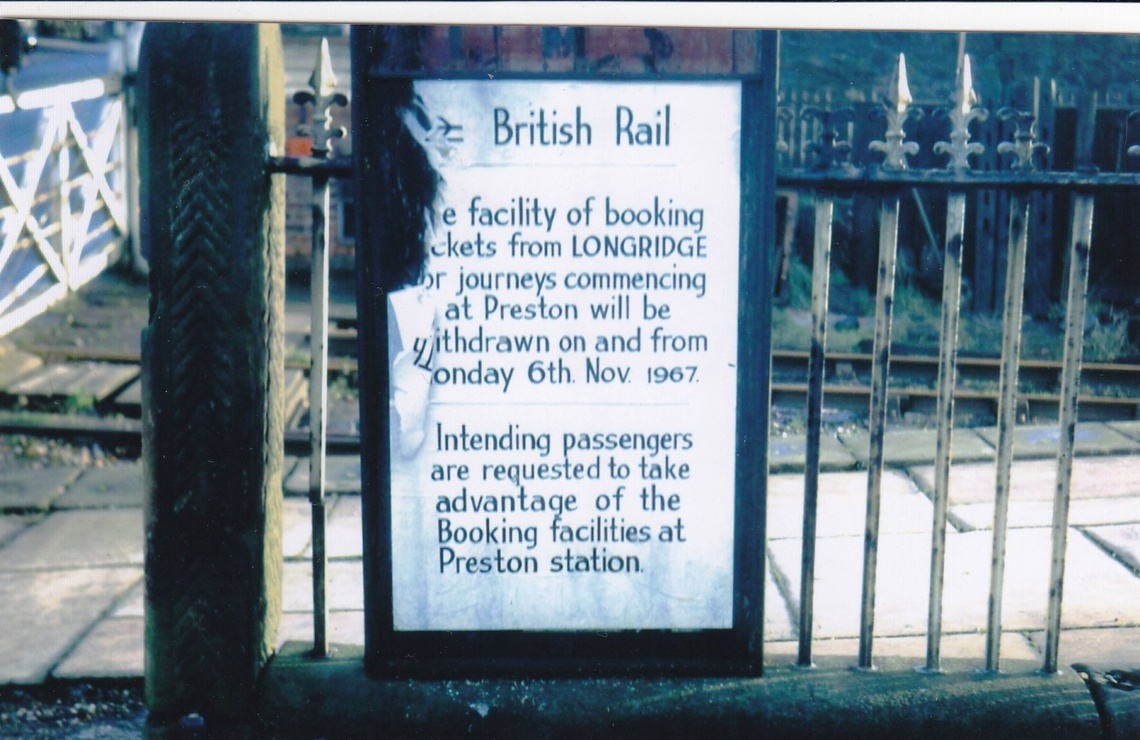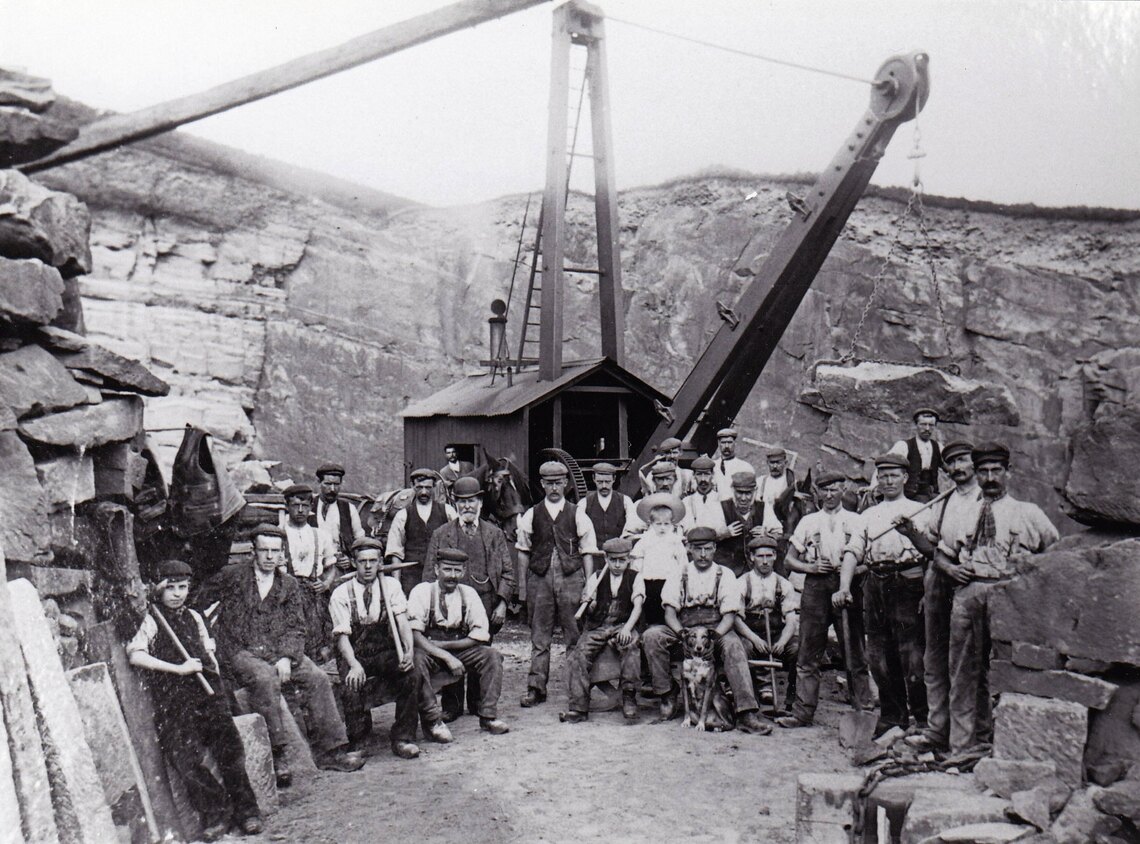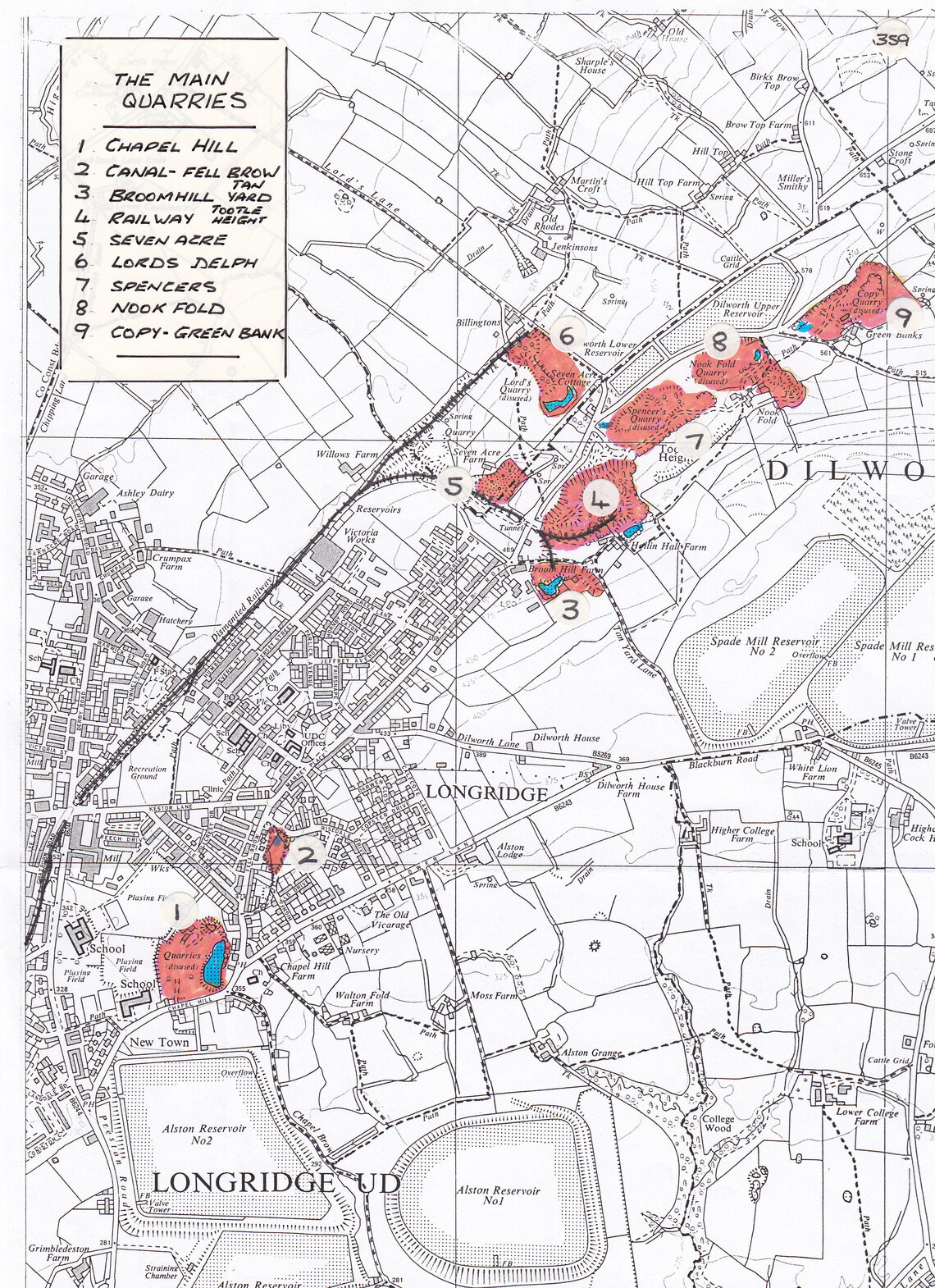Every month, the Heritage Centre submits an article on aspects of local history to a local free magazine, the 'PR Pointer' that is distributed across Longridge and Preston.
Copies of the current and previous articles can be seen below.
December 2025
Archive photo of the month
Our picture for December is of a postcard, postmarked Christmas Eve 1903. We join with the sender in wishing you a Merry Christmas from all the volunteers!
The Heritage Centre is open between 10.00 and 2.00, Monday to Friday. We sell a selection of cards, books, maps, local photographs and small gifts. Our frequently changing corridor displays can be seen during the station opening hours of 9.00 to 4.00, Monday to Saturday
The Old Station, Berry Lane, Longridge PR3 3JP Tel: 01772 437958
Email info@lhctrust.org.uk Website lhctrust.org.uk
November 2025
Archive photo of the month
Each month we share an image from our archive of several thousand photos of Longridge and the surrounding area, dating from the late 19 th century to recent times. Our picture for November is ofthe Longridge Territorials on a route march in 1912. Which of these young men went to war two years later and how many came home?
The Heritage Centre is open between 10.00 and 2.00, Monday to Friday. We sell a selection of cards, books, maps, local photographs and small gifts. Our frequently changing corridor displays can be seen during station opening hours of 9.00 to 4.00, Monday to Saturday
The Old Station, Berry Lane, Longridge PR3 3JP Tel: 07344 119262
Email info@lhctrust.org.uk Website lhctrust.org.uk longridgeheritagecentre
October 2025
Archive photo of the month
Each month we share an image from our archive of several thousand photos of Longridge and the surrounding area, dating from the late 19th century to recent times. Following on from our participation in the National Heritage Open Event in September, which featured our display ‘Built on Stone’, this month’s photo shows the workers at the Nook Field Quarry in 1899.
The Heritage Centre is open between 10.00 and 2.00, Monday to Friday. We sell a selection of cards, books, maps, local photographs and small gifts. Our frequently changing corridor displays can be seen during station opening hours of 9.00 to 4.00, Monday to Saturday
The Old Station, Berry Lane, Longridge PR3 3JP Tel: 01772 437958
Email: info@lhctrust.org.uk
Website: www.lhctrust.org.uk
September 2025
Archive photo of the month
Each month we share an image from our archive of several thousand photos of Longridge and the surrounding area, dating from the late 19th century to recent times. September sees the start of a new school year and our photo shows a class of smart young boys at Berry Lane School in 1915.
Don’t forget we are joining in with the national Heritage Open Weekend on Saturday 20th September with our display ‘Built on Stone’, featuring the heritage buildings of Longridge. The Heritage Centre is open between 10.00 and 2.00, Monday to Friday. We sell a selection of cards, books, maps, local photographs and small gifts.
Our frequently changing corridor displays can be seen during station opening hours of 9.00 to 4.00, Monday to Saturday
The Old Station, Berry Lane, Longridge PR3 3JP Tel: 01772 437958
Email info@lhctrust.org.uk Website lhctrust.org.uk
July 2025
Archive photo of the month
Longridge Heritage Centre Trust is the custodian of an archive of several thousand photos of Longridge and the surrounding area, dating from the late 19th century to recent times. Each month we share an image from our collection. This month, a group of neighbours from Regent Street and Victoria Street sets off on a charabanc trip to Blackpool in 1925. This photo features in our new booklet ‘Longridge in Pictures’, £6 from the Heritage Centre.
Our current corridor display celebrates summer events in Lancashire and will also mark the 80th anniversary of VJ Day..
The Heritage Centre is open between 10.00 and 2.00, Monday to Friday. We sell a selection of cards, books, maps, local photographs and small gifts. Our frequently changing corridor displays can be seen during station opening hours of 9.00 to 4.00, Monday to Saturday
The Old Station, Berry Lane, Longridge PR3 3JP Tel: 01772 437958
Email info@lhctrust.org.uk Website lhctrust.org.uk
July 2025
Archive photo of the month
Longridge Heritage Centre Trust is the custodian of an archive of several thousand photos of Longridge and the surrounding area, dating from the late 19 th century to recent times. Each month, we will share an image from our collection along with some background information.
Our first picture is of an old pub sign, The Grey Horse.
This pub was among the cottages in Newtown but the sign will be more familiar in its present position above the exit door of our much missed Palace Cinema. Over the years, pubs have come and gone – a total of 20 have beenrecorded in the Longridge district. Some have been demolished, some converted to other uses including housing but six within the town continue to serve the thirsty and hungry of Longridge’
The pubs of Longridge will feature in our Heritage Open Day display on Saturday 20 th September, when we will join the national theme of ‘Architecture and Design’.
The Heritage Centre is open between 10.00 and 2.00, Monday to Friday. We sell a selection of cards, books, maps, local photographs and small gifts. Our frequently changing corridor displays can be seen during station opening hours of 9.00 to 4.00, Monday to Saturday
The Old Station, Berry Lane, Longridge PR3 3JP Tel: 01772 437958
Email info@lhctrust.org.uk Website lhctrust.org.uk
June 2025 Longridge – a growing town
We are all aware that Longridge is growing, with new housing developments in all directions. But this is nothing new. Changes in industry and employment patterns have led to an almost continuous growth in the number of residents since Victorian times.
In 1841 the population of Longridge parish was 1652, largely rural and quarry workers and hand loom weavers. The steam train service from Preston started in 1848 and during the next 5 years two mills were built; by 1861 the population had grown to 2057. The real boom in the village (as it was still seen) came in the next 10 years, with the construction of another mill and rows of terraced houses for the workers, resulting in a 50% rise in the population to 3067 by 1871. Another 650 people lived in Longridge by 1881 and the number of residents continued to grow until1911, when the population was 4340.
War years and a declining textile industry led to a fall in numbers, with 4206 Longridge residents entering the WWII years in 1939. Since then, Longridge has grown steadily, with a surge in the 1970s with the building of the Monk’s and Wellbrow estates. By 2001, over 7500 people enjoyed life in what was becoming a small town. The latest census in 2021 counted 8282 residents.
Interest residents, old and new, can see the changes in Longridge over the years in our two books of photos ‘Longridge in Pictures’ - The Victorian and Edwardian Years and The Home Front 1910 – 1950. Both are on sale at the Heritage Centre at £6 each.
Our corridor displays can be seen during Station opening times of 9 to 4, Monday to Saturday. The Heritage Centre is open between 10 and 2, Monday to Friday. We sell a selection of cards, books, maps, local photographs and small gifts.
The Old Station, Berry Lane, Longridge PR3 3JP Tel: 01772 437958
Email info@lhctrust.org.uk Website lhctrust.org.uk
VE Day celebrations
May 8th 2025 is the 80th anniversary of VE (Victory in Europe) Day when the Allies of WWII accepted Germany’s unconditional surrender. The German Instrument of Surrender was signed in Berlin at 22.43 local time and included the statement The German High Command will at once issue orders to all German military, naval and air authorities and to all forces under German control to cease active operations at 23.01 hours Central European time on 8 May 1945..So ended almost 6 years of conflict in Europe, although the war did not come to a final end until August the same year, with the surrender of Japan following the dropping of the atomic bombs in Hiroshima and Nagasaki. VJ Day is marked on 15th August.
On VE Day huge crowds gathered in London, in Trafalgar Square, the Mall and in front of Buckingham Palace to cheer Winston Churchill and the Royal Family. Churchill declared ‘God bless you all. This is your victory. In our long history, we have never seen a greater day than this. Everyone, man or woman, has done their best’. More than a million people flooded the streets throughout the UK.
Both VE and VJ Day were celebrated nationwide, with street parties and other events. Our picture shows a street party behind Hillcrest Avenue. This year, Longridge will be celebrating again on Saturday 3rd May, with a recreation of a street party at the Old Station and other events at the Civic Hall and throughout the town. The anniversary itself will be marked on the evening of 8th May with the lighting of a beacon and flag raising at the Old Station, accompanied by music from Longridge Band.
To coincide with VE Day, Longridge Heritage Centre Trust is publishing a second volume of its popular book Longridge in Pictures. Subtitled ‘1910 – 1950, The Home Front’, this will be available from the Heritage Centre from early May priced at £6. Our May corridor display will also mark the anniversary of the ending of the War.
Our corridor displays can be seen during Station opening times of 9 to 4, Monday to Saturday. The Heritage Centre is open between 10 and 2, Monday to Friday. We sell a selection of cards, books, maps, local photographs and small gifts.
The Old Station, Berry Lane, Longridge PR3 3JP Tel: 01772 437958
Email info@lhctrust.org.uk or Longridgeheritagecentre@outlook.com Website lhctrust.org.uk
200 Years of the Railways
2025 marks the 200 th anniversary of the launch of the railway system in Britain. It was on 27 th
September 1825 that the Stockton and Darlington Railway opened, a day of local holiday and
arousing interest all over the country. Four years later, the iconic Stephenson’s ‘Rocket’
demonstrated the viability of the steam locomotive and a new era of public transport began.
Through the 1840s and 50s communities grew and flourished through their connections to the
railways. In 1840 Longridge was linked to Preston by a gravity operated railway serving the local
quarries but it was the introduction of a steam powered service in 1848, enabling transport of
materials and fuel, that gave a boost to the cotton weaving industry that came to dominate the
village.
Nationally, Greenwich Mean Time was the standard time adopted by railway companies to ensure
punctuality and by 1855 almost the whole of Britain had followed suit and used ‘Railway Time’,
replacing local time zones. Trains became a popular way of travelling on holiday – in 1860,
23,000 visitors arrived in Blackpool by train. Standard gauge lines connected all mainline stations
by 1892. By the early 1900s, electric trains were introduced in many areas, including on the
Lancashire and Yorkshire Railway.
The network was severely cut following the Beeching Report in 1963. The railways were
nationalised in 1948, privatised in 1994 and plans made to take them back into public ownership in
2024. Eurostar has encouraged rail travel between London and Europe and work continues on
the controversial HS2 line to London.
As part of the national Railway 200 celebrations, our April corridor display will cover the history of
our local line and services which sadly came to an end in 1967. Our photo is of a train
approaching Longridge Station in 1912, the railway’s heyday.
Can you help?
May 8 th is the 80 th anniversary of VE (Victory in Europe) Day when the Allies of WWII accepted
Germany’s unconditional surrender. This was celebrated throughout the country, with street
parties and other events. We will be putting on a display to mark this occasion and would very
much like to hear from anyone who has memories or stories from the day and particularly any
photos of Longridge at that time. Please call into the Heritage Centre (between 10 and 2 on
weekdays) if you have anything you would like to share with us.
Our corridor displays can be seen during Station opening times of 9 to 4, Monday to Saturday.
The Heritage Centre is open between 10 and 2, Monday to Friday. We sell a selection of cards,
books, maps, local photographs and small gifts.
The Old Station, Berry Lane, Longridge PR3 3JP Tel: 01772 437958
Email info@lhctrust.org.uk Website lhctrust.org.uk longridgeheritagecentre
March 2025 - Ladies of Longridge
Coinciding with International Women’s Day on March 8th, the Old Station corridor display this month celebrates the lives and contributions to the town of the ‘Ladies of Longridge’.
Our earliest notables are sisters Grace Watson and Ellen Riley, both born in the early years of the 19th century. Grace is described in Tom Smith’s History of Longridge as: “A well-known character … who for many years used to cart stones to Preston from Messrs. Cooper and Tullis’ quarry. She wore a top coat, thick boots, and looked outwardly very like a man. She lived at Nook Fold, and there are in existence a couple of very primitive water-colour sketches of the Amazon, her mother, and her horse”. Her sister’s obituary in the Preston Chronicle in 1878 says “Mrs. Riley, at her death, was 76 years of age, and when young, before the restriction laws came in force, she regularly shouldered her pick and heavy sledge hammer in the stone delphs, working there just as the men do now, and it is said that few men could turn off more work than she did. She also used to assist in using a kind of treadmill crane, used for raising stone, long before the steam or travelling cranes were invented.”
As we come forward through the centuries we meet a respected head teacher of Berry Lane School, the first woman to be Mayor of the Ribble Valley, the last Cotton Queen and the proprietor of the Palace Cinema. Women’s war time service is remembered, and two women who played a prominent role in our local dairy industry. Coming up to date, we feature current leading lights including, of course, our famous Lollypop Lady Irene Reid and her no less dedicated colleagues, along with representatives of sporting and social organisations and our new MP. Our most poignant piece was written for us just days before her death by well-known ex-mayor Hilda Marle Collis, who was active in so many organisations in Longridge.
Our picture shows a world-famous Longridge face – that of Grandma Singleton.
Our corridor displays can be seen during Station opening times of 9 to 4, Monday to Saturday. The Heritage Centre is open between 10 and 2, Monday to Friday. We sell a selection of cards, books, maps, local photographs and small gifts.
The Old Station, Berry Lane, Longridge PR3 3JP Tel: 01772 437958
February 2025 - Queens of Industry
A largely forgotten feature of our industrial past is the selection of ‘Queens’ to represent and celebrate manufacturing, transport and other enterprises, nationally and even internationally. For around 60 years, girls either working in or from families involved in the great industries of the early 20 th century were chosen to reign for a year. The first, a Railway Queen, was elected in the 1920sand the last Coal Queen held office in the early 1980s.
Although conventional beauty was the starting point, successful Queens had to show a knowledge of their industry and an ability to talk about it, sometimes to large audiences. The schedule was demanding – some girls had around 150 engagements in a year, from opening local events to attending trade fairs. One Railway Queen was sent on a good will visit to Russia in 1936, whereshe had to operate under the watchful eye of the Stalin regime.
The ‘Cotton Queen Quest’ was launched by the Daily Despatch newspaper in 1930. Girls working in the cotton industry were invited to send in a photograph of themselves, and a representative from each mill town was chosen for the final in Blackpool. At some mills, the managers made suretheir candidate was primed for the contest by putting her through all the departments so she could talk with authority – they were well aware of the good publicity the successful Queen wouldgenerate for her employer.
In June 1939, 19 year old Elsie Kearsley, a weaver at George Whittle’s Stonebridge Mill, was crowned Cotton Queen at her third attempt. The daughter of the local police sergeant, Elsie had left school at 14 to take up employment in the local textile industry. She embarked on her year of duties, but the onset of war in September put an end to this and she returned to her work in the mill. The competition was never revived so Elsie became the last of the Cotton Queens and retained her tiara for the rest of her life. Longridge Heritage Centre is now the custodian of the Cotton Queen tiara. Our February corridor display celebrates ‘Ladies of Longridge’ and includes Elsie’s story along with those of other
women who have contributed to public life in the town and further afield.
Our photo shows Elsie making a presentation at Belle Vue race track in Manchester during her 3 month reign.
Our corridor displays can be seen during Station opening times of 9 to 4, Monday to Saturday. The Heritage Centre is open between 10 and 2, Monday to Friday. We sell a selection of cards, books, maps, local photographs and small gifts. Our new book of photos of Victorian and
Edwardian Longridge is now available, price £5
The Old Station, Berry Lane, Longridge PR3 3JP
Tel: 01772 437958 Email info@lhctrust.org.uk website lhctrust.org.uk
January 2025
Happy New Year from all at the Heritage Centre!
Early cotton weaving
Our corridor display in January will be on the cotton industry, which had such an impact on the development of Longridge. Before industrialisation, cloth was largely produced by handloom weavers working in their own homes. Over the 17th and 18th centuries, a system grew up to improve efficiency and profitability and to increase access to wider markets. This was known as ‘putting-out’ and involved a network of merchants, middlemen and weavers.
Cloth merchants in the larger centres of population provided yarn to country agents who in turn supplied, or ‘put-out’ to, the home-based weavers, either themselves or using ‘putters-out’. The finished cloth then passed back up the line to the merchant, who could access national or even export markets. The cost of the yarn was set against the price paid for the finished cloth so the weavers did not pay up front for their materials.
The design of cottages built in Longridge in the late 1700s and early 1800s was influenced by the handloom weaving trade. Cottages in Club Row and King Street had semi-basement work rooms whose slightly damp atmosphere was ideal for cotton weaving. In Newtown, workshops intended for weavers opened internally off the living quarters and had no direct access to the outside, which would have let in fresh air to dry the atmosphere. Here, completed cloth was stored in a communal warehouse ready for collection by the ‘putter-out’.
In 1838 a ‘putter-out’ who would influence the future of Longridge arrived in the village. George Whittle was the son of a Manchester handloom manufacturer who himself employed several ‘putters-out’. Whittle junior ‘put-out’ to weavers in Hurst Green, Goosnargh, Ribchester and as far afield as Newton, as well as in Longridge. According to Tom Smith’s History of Longridge, George Whittle walked to most of these places weekly.
By 1850 steam trains had come to Longridge and George Whittle built ‘Stone Bridge Mill’, the first steam powered weaving shed in Longridge and the first of the four mills eventually built in the village. Gradually industrialised production of cloth took over from the handloom weavers; textile workers now came to a centralised work-place and at set times rather than the work coming to them to carry out at a time to suit themselves.
Our corridor displays can be seen during Station opening times of 9 to 4, Monday to Saturday. The Heritage Centre is open between 10 and 2, Monday to Friday. We sell a selection of cards, books, maps, local photographs and small gifts. Our new book of photos of Victorian and Edwardian Longridge is now available, price £5
The Old Station, Berry Lane, Longridge PR3 3JP Tel: 01772 437958
Email info@lhctrust.org.uk website lhctrust.org.uk
December 2024
November 2024
As the year rolls round, we will once again be marking Remembrance Day. Our corridor display through most of November will focus on medals awarded during various conflicts and the stories of the individuals behind them. One such is Driver John Whittle, who lived at Pinfold Cottage between Longridge and Ribchester and later on the Mardale estate. He served in the Royal Army Service Corps attached to the 8th Army in North Africa and Italy. His medal rack, shown in our picture, from L to R comprises the 1939 – 1945 Star, the Africa Star (with 8th Army clasp), the Italy Star, the 1939 - 1945 War Medal and the Defence Medal. The Oak Leaf Emblem on the ribbon of the War Medal indicates that he was Mentioned in Despatches. Another section of the display will tell of Norman Proctor, who served in the Royal Navy in the Atlantic convoys to North Russia during WW2. In these troubled times, it is timely to be reminded of the hardships and sacrifices of those who played their parts in conflicts of the past.
Later in the month, our thoughts turn to the festive season and, in particular, Longridge Does Christmas. Celebrating the new 3 day format, our corridor display will showcase the shops’ late night opening evening on Thursday 28th November, Foodie Friday at the Civic Hall on the 29th and the Artisan Market in Towneley Gardens on Saturday 30th. The Heritage Centre will be open during the Thursday evening.
Our corridor displays can be seen during Station opening times of 9 to 4, Monday to Saturday. The Heritage Centre is open between 10 and 2, Monday to Friday. We sell a selection of cards, books, maps, local photographs and small gifts.
The Old Station, Berry Lane, Longridge PR3 3JP
Tel: 01772 437958 Email info@lhctrust.org.uk
October 2024
Celebration at the Station
Early September saw a busy weekend in the Old Station in Longridge. Not only did we join in with the national Heritage Open Days event on the Saturday by opening a pop-up museum on the theme of Routes, Networks and Connections but we also hosted a small celebration event on the Sunday to mark the 10 th anniversary of the formation of the Longridge Heritage Centre Trust as a charity.
Longridge Station opened in 1872 to serve the growing demand from passenger using the trains to Preston. Before that date, passengers bought their tickets at the Towneley Arms (previously called the Railway Tavern and then the Station Hotel). From its platform the volunteers and conscripts of the First World War set off to fight for their country, some leaving Longridge for the last time.
The last scheduled passenger train left Longridge in 1930 but until freight services also ceased in 1967 you could still buy your ticket for journeys from Preston at Longridge Station (see our archive photo). After this, for a time the building had several uses. Rooms housed the Longridge Homing Pigeon Society and the St. John Ambulance group. Part of the building was home to the Town Council Chambers and Ribble Valley had a collection office for rent and rates. However, over the years the condition of the building gradually deteriorated until in September 2000 the wheels were set in motion to restore one of Longridge`s most historic buildings.
Our new display boards about the Railway (funded in part by the Duchy of Lancaster and Longridge Town Council) include a section on the rehabilitation and renovation of the Station buildings, initiated by a proposal from the Longridge Heritage Committee in 2000. After years of planning and fund raising the restored building opened in 2010 and included a café, the Heritage Centre, Council offices and a meeting room.
The Station has become a hub for the community, although sadly some new-comers to the town have not yet discovered it. Many local groups hold their meetings here, including the ‘Café Artists’, who will be showing their work in a pop-up exhibition in the conservatory meeting room on Saturday 12 th October.
Our Railway display can be seen during Station opening times of 9 to 4, Monday to Saturday through October. The Centre is open between 10 and 2, Monday to Friday. We sell a selection of cards, books, maps, local photographs and small gifts.
The Old Station, Berry Lane, Longridge PR3 3JP
Tel: 01772 437958 Email info@lhctrust.org.uk
August 2024
Longridge Heritage Centre will be joining in the annual Heritage Open Days event in September, with displays illustrating the national theme of ‘Routes – Networks – Connections’.
One route through Longridge had a profound effect on British history. In 1648 Oliver Cromwell had been in power for 3 years and King Charles I was under house arrest on the Isle of Wight. But Charles was able to communicate with his allies and encouraged a series of uprisings across England and Wales. In addition, there was an invasion from the north by a Scottish Royalist army under the command of the Duke of Hamilton.
After putting down a major rebellion in Pembrokeshire, Cromwell hurried his troops to Yorkshire, where he joined forces with the Northern Parliamentary army near Otley. Learning that Hamilton’s army was spread out between Preston and Wigan, Cromwell set off from Otley on 14th August to engage the invaders.
Cromwell’s route took him from Otley to Skipton on the first day. The next day, following the river Aire and then the Ribble, the army marched on to Guisburn. On 16th August they followed the north bank of the Ribble and crossed the river Hodder at Great Mitton, over the bridge now known as Cromwell’s Bridge. Cromwell billeted himself at Stonyhurst, where he is reputed to have slept on an oak table ,in full armour for fear of assassination..
The march resumed very early the next morning. The first skirmish of the day took place in Longridge, on the site of a chapel where St Lawrence’s church now stands. Cromwell’s troops then continued down the Ribble and engaged the enemy on Preston Moor and at Walton Bridge. The Roundhead army were outnumbered but more disciplined and over 3 days pursued the Royalists south to Warrington where they eventually took the surrender.
The Battle of Preston marked the beginning of the end of this second Civil War. The commanders of the uprising were executed or escaped abroad. Charles I was beheaded on January 30th 1649.
‘It is said that Longridge owes its name to Oliver Cromwell who, when on his way across the fields from Stonyhurst to Preston, said, “What a long ridge this is”. But, pretty as this tale is, history compels us to relegate it to the lumber room, to which are consigned so many similar romantic stories. For mention is made in 1554 … of ‘Sir Robert Cotome, priest of Longryche in Ribblechester’’
Tom Smith ‘A History of Longridge and District’ pub 1888
Our LongridgeHeritage Open Day will be Saturday 7th September
The Longridge Heritage Centre is open between 10 and 2, Monday to Friday. Our corridor displays are on view during the Station opening times of 9 to 4, Monday to Saturday
July 2024
After last year’s successful debut, the volunteers at the Heritage Centre are preparing to take part once again in the national Heritage Open Days event in September. England’s largest festival of history and culture will this year have the theme of ‘Routes – Networks – Connections’ so we are busy looking into Oliver Cromwell’s route through Longridge to the decisive Battle of Preston, the railway network linking Longridge to Preston and Whittingham, a balloon flight (that didn’t quite make it to Longridge!) in 1849, the network supporting the pre-industrial textile industry and much more under the heading ‘Romans to Railways’. Our open day here will be Saturday 7th September, more details to follow next month.
In the meantime our corridor display will feature a look at the history of the Goosnargh and Longridge Agricultural Show (GLAS), which dates from around 150 years ago and this year will be held on the show field on Lower Lane on Saturday 6th July. Following on from this we will celebrate all the wonderful things to do in Lancashire through the summer, from days out at the seaside to field days and festivals. All we need is the weather!
Our picture shows a busy corner of Blackpool full of trippers enjoying their day at the seaside in the early 1900s. This is the original location of ‘Uncle Tom’s Cabin’ which was Blackpool’s first centre for amusements and inspired many more to follow. Unfortunately, erosion of the coast caused much of the building to collapse soon after this photo was taken and the business moved to Queen’s Promenade.
We will be in the Community Tent at the GLAS with a display and a selection of our local books, maps and small gifts for sale, including our new leaflet on the Longridge Blue Plaque Trail. Why not come and visit us?
The Longridge Heritage Centre is open between 10 and 2, Monday to Friday. Our corridor displays are on view during the Station opening times of 9 to 4, Monday to Saturday
June 2024
Parades and Processions
The people of Longridge have enjoyed a good parade through the streets of the village for decades if not centuries. The tradition started with the Whitsuntide walks when Sunday School scholars marched to church accompanied by bands and then, after the service, continued to another venue (inside or out) for a tea and further entertainment. An early report of such a procession appears in the Preston Chronicle in June 1846. Whit Monday at that time was not on a fixed date as is our late May Bank Holiday, but was a religious festival with timing determined by Easter.
Another excuse for a parade was Longridge Guild Day in August. In 1890 crowds came to Longridge on special trains to join in the festivities. The congregations of the Catholic and Protestant churches held their own processions and services then came together to follow a common route before separating again for refreshments.
Parades were also held to mark one-off events – recruitment of men to the First World War, peace celebrations. Until very recently, the annual Civic Sunday in Longridge was marked by the Mayor inviting all residents of the village to join them in a walk round the streets and ending in a local church for a service of thanksgiving and dedication. By 2013 attendance by uniformed organisations was dwindling and soon afterwards the tradition came to an end.
The main parade through our streets now is for Field Day in June each year, when floats lavishly decorated by schools and other community groups share the streets with Field Day Queens, dancers, musicians, gymnasts, fancy dress and other displays.
The current Heritage Centre corridor display features photos of Longridge parades over the past 100 years and can be seen during Station opening times of 9 to 4, Monday to Saturday.
April 2024
Longridge stone – the building blocks of West Lancashire
Longridge Fell is formed of millstone grit sandstone, an excellent building material which has been quarried since at least the 1700s and possibly earlier. Known as Longridge Brown, the stone was at first used for building in the village itself. As knowledge of its fine properties spread, quarrymasters forged links with developers across the county to create a thriving market and an expansion in the number and size of quarries spreading up the Fell.
Huge blocks of stone were at first transported to Preston docks by horse drawn ’lurries’ pulled by teams of up to 16 horses for onward shipping. Quarry owner Thomas Fleming was one of the main promoters of the 1840 gravity railway to Preston, converted to steam locomotion in 1848, which facilitated the export of the stone around Lancashire. The major civic buildings in Preston are constructed of our stone, as are the town halls of Blackburn and Lancaster, Bolton parish church and the Liverpool, Fleetwood and Preston docks.
At the height of production the main quarries were Broomhill (off Tan Yard), Railway, Spencer’s and Nook Fold (now together the location of the Beacon Fell View Holiday Park), and Copy or Green Bank , now the site of holiday homes and a well-used ‘bouldering’ climbing face. On the other side of the ridge was Lord’s Delph, close to Billington’s Farm.. The quarries at one time employed 400 men. The railway ran beyond the town as far as Lord’s Delph and through a tunnel under Higher Road to serve the quarries at Tootle Heights; trucks had to be winched by rope through this as engines became too large to get through.
The demand for Longridge stone collapsed by 1918, due to competition from Yorkshire and Wales, the costs of carriage and the increasing use of bricks in building. The last of the quarries closed shortly after the Second World War, although Copy Quarry reopened briefly in the 1970s to supply hardcore for the construction of the M55 to Blackpool. Slightly further afield, Leeming Quarry at Kemple End is still operating and supplied the slab of stone used to mark 100 years since the end of WW1 in the Longridge Rec.
Our pictures shows workers at Nook Fold in 1899 and a line drawing of the local quarries
Our next corridor display will give more detail about our quarrying past. To learn more about the history of Longridge, its industries and commerce, why not buy a copy of ‘Our Heritage’, an A – Z guide to our town, available from the Heritage Centre.
The Longridge Heritage Centre corridor displays can be seen during Station opening times of 9 to 4, Monday to Saturday. The Centre is open between 10 and 2, Monday to Friday. We sell a selection of cards, books, maps, local photographs and small gifts.
March 2024
Victorian and Edwardian Longridge
Our corridor display opening at the end of February is a pictorial celebration of Longridge through the Victorian and Edwardian eras.
Until the middle years of the 19th century, Longridge was a village of mainly home workers – hand loom weavers and nail makers. The only industry of any scale was quarrying, which had been carried out on Longridge Fell on the outskirts of the settlement for centuries. The stone was transported away by horse and cart until 1840, just one year after Victoria came to the throne, when the railway down to Preston opened. This was operated by gravity and hauled back to Longridge by horse power. The population of the village in 1841 was 1652. Steam trains came to the line in 1848 and opened the way for transporting raw materials, especially coal and cotton, up to Longridge. Very soon the cotton mills were built and started production – Stonebridge in 1850, Cramp Oaks (Crumpax) a year later, Victoria in 1862 (shown in our picture) and finally Queens in 1875.
These mills needed workers and workers needed housing. The characteristic terraces off Berry Lane and elsewhere in Longridge began to appear in 1860 and house building continued apace throughout the next decade and beyond. The population increased, at first slowly, but between 1861 and 1871 it grew by 50% to just over 3000. In 1901, the year Victoria died, 4304 people were recorded in the census. These residents needed services and during the last 4 decades of Victoria’s reign schools and churches were built, The Longridge Co-op was formed, the railway station opened to serve passengers (who had previously had to buy their tickets at the Towneley Arms), a gas works came into production and the whole social network of a thriving community was built up. Longridge Urban District Council was created in 1894 to run the affairs of the town.
The Edwardian era lasted just under 10 years from 1901 until 1910. This was a time of stability in Longridge. The population remained at just over 4300, the mills were thriving and life seemed set to continue in this vein indefinitely. The people of Longridge could not have foreseen the disruption to their lives to come in 1914.
The Longridge Heritage Centre corridor displays can be seen during Station opening times of 9 to 4, Monday to Saturday. The Centre is open between 10 and 2, Monday to Friday. We sell a selection of cards, books, maps, local photographs and small gifts.

